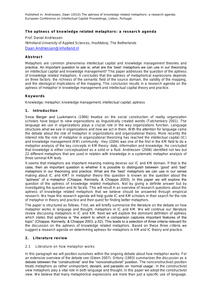In the course of our supervisory work over the years, we have noticed that qualitative research tends to evoke a lot of questions and worries, so-called Frequently Asked Questions. This journal series of four articles intends to provide novice researchers with practical guidance for conducting high-quality qualitative research in primary care. By ‘novice’ we mean Master’s students and junior researchers, as well as experienced quantitative researchers who are engaging in qualitative research for the first time. This series addresses their questions and provides researchers, readers, reviewers and editors with references to criteria and tools for judging the quality of papers reporting on qualitative research. This first article describes the key features of qualitative research, provides publications for further learning and reading, and gives an outline of the series.
DOCUMENT

No summary available
DOCUMENT
Hoofdstuk 12 uit deel III: Uses of cultural technologies. The essays in this volume discuss both the culture of technology that we live in today, and culture as technology. Within the chapters of the book cultures of technology and cultural technologies are discussed, focussing on a variety of examples, from varied national contexts. The book brings together internationally recognised scholars from the social sciences and humanities, covering diverse themes such as intellectual property, server farms and search engines, cultural technologies and epistemology, virtual embassies, surveillance, peer-to-peer file-sharing, sound media and nostalgia and much more. It contains both historical and contemporary analyses of technological phenomena as well as epistemological discussions on the uses of technology.
LINK
Metaphors are at the basis of our understanding of reality. Using the theory of metaphor developed by Lakoff and Johnson (1980, 1999) this paper analyses common metaphors used in the intellectual capital and knowledge management literatures. An analysis of key works by Davenport & Prusak (2000), Nonaka & Takeuchi (1995), and Stewart (1991) suggests that at least 95 percent of all statements about either knowledge or intellectual capital are based on metaphors. The paper analyses the two metaphors that form the basis for the concept of intellectual capital: ‘Knowledge as a Resource’ and ‘Knowledge as Capital’, both of which derive their foundations from the industrial age. The paper goes into some of the implications of these findings for the theory and practice of intellectual capital. Common metaphors used in conceptualising abstract phenomena in traditional management practices unconsciously reinforce the established social order. The paper concludes by asking whether we need new metaphors to better understand the mechanisms of the knowledge economy, hence allowing us to potentially change some of the more negative structural features of contemporary society.
DOCUMENT

The characteristics of comparative social research.
DOCUMENT

Metaphors are common phenomena intellectual capital and knowledge management theories and practice. An important question to ask is: what are the ‗best‘ metaphors we can use in our theorizing on intellectual capital and knowledge management? This paper addresses the question of the aptness of knowledge related metaphors. It concludes that the aptness of metaphorical expressions depends on three factors: the richness of the semantic field of the source domain, the validity of the mapping, and the ideological implications of the mapping. This conclusion results in a research agenda on the aptness of metaphor in knowledge management and intellectual capital theory and practice.
DOCUMENT

Nowadays, digital tools for mathematics education are sophisticated and widely available. These tools offer important opportunities, but also come with constraints. Some tools are hard to tailor by teachers, educational designers and researchers; their functionality has to be taken for granted. Other tools offer many possible educational applications, which require didactical choices. In both cases, one may experience a tension between a teacher’s didactical goals and the tool’s affordances. From the perspective of Realistic Mathematics Education (RME), this challenge concerns both guided reinvention and didactical phenomenology. In this chapter, this dialectic relationship will be addressed through the description of two particular cases of using digital tools in Dutch mathematics education: the introduction of the graphing calculator (GC), and the evolution of the online Digital Mathematics Environment (DME). From these two case descriptions, my conclusion is that students need to develop new techniques for using digital tools; techniques that interact with conceptual understanding. For teachers, it is important to be able to tailor the digital tool to their didactical intentions. From the perspective of RME, I conclude that its match with using digital technology is not self-evident. Guided reinvention may be challenged by the rigid character of the tools, and the phenomena that form the point of departure of the learning of mathematics may change in a technology-rich classroom.
LINK
Humans use metaphors in thinking. Most metaphors are visual. In processing information stimuli the mind depends partly on visual codes. Information is processed and stored through two channels: one for non-verbal information and another for verbal information. The two different areas of information in the brain are interconnected. The information is stored in patterns that form an inner representation of how individuals perceive their reality and their self. The active processing of new information, remembering and the self-image are related phenomena, that influence each other, sometimes leading to biased interpretation or even reconstruction of contents in each of these areas. Imagination, expectations and anticipations of the future and memories are the more active manifestations of this process. In this process mimesis plays an important role. Mimesis is the imitation of reality in play, story-telling or creating images of how things should look like in the future. Through mimesis people can anticipate on roles in social life, or appropriate experiences from someone else and relate them to one’s own life story. When this happens the information is related to the self through processes of association and becomes ‘Erfahrung’.
DOCUMENT
